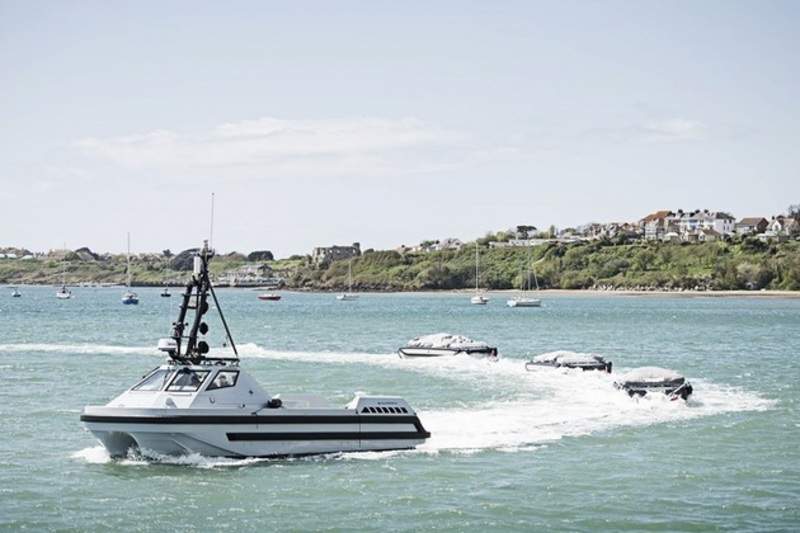Sea mines are one of the cheapest and most dangerous threats for Naval forces; a reality experienced in both World Wars and the Korean War. In order to mitigate the impacts and risks of sea mines on naval operations, advanced navies have been increasing their investments in autonomous Mine Countermeasure (MCM) capabilities for two decades. For instance, the US Navy has launched the Littoral Combat Ship Mission Modules (LCS MM) Programme comprising 48 unmanned surface vehicles (USV) procured for both Unmanned Mine Sweeping (UMS) and Remote Mine hunting (RMH) modules to perform mine-hunting missions. The Unmanned MCM USV will be a long-endurance, semi-autonomous, diesel-powered, all-aluminium surface craft that supports the employment of various MCM payloads, such as Minesweeping Payload Delivery Systems (PDS), mine hunting PDS and PDSs for future payloads, including Mine Neutralisation. It would facilitate the entire detect-to-engage process in a single MCM sortie. Knifefish and Barracuda Unmanned underwater vehicles (UUV) will be used in the MCM modules. Besides, Orca XLUUV and its micro-sized UUVs could take part in MCM missions without alerting the enemy.
The UK and France have a joint Maritime Mine Countermeasures (MMCM) programme to harness the potential of maritime autonomy in the mine-hunting role and reduce the risk to the sailor in the minefield. The program will comprise a USV equipped with an autonomous navigation system, obstacle detection and avoidance sonar, threat identification and neutralisation capability based on Remotely Operated Vehicles (ROV), a Towed Synthetic Aperture Sonar (T-SAS) and Autonomous Underwater Vehicles (AUV). The first equipment is expected to be delivered in the last quarter of 2022. In addition to this, the NELSON programme, an innovation programme within the Royal Navy focused on using AI and data science to build a ‘Ship’s Mind’ enabling better decision making, includes a Route Survey Tasking and Analytics (RSTA) project that will adopt autonomous vehicles, open architectures and AI, with the intention to deliver an unmanned capability for routine MCM tasks in UK waters by 2022.
The UK MoD is also investing in a Mine and Hydrographic Capability (MHC) program. This seeks to procure three UUV to conduct mine warfare missions from USVs. Similarly, the Belgian and Dutch Navies will replace their aging fleets of Tripartite-class vessels from 2023. Under the MCM programme, the Belgium Naval and Robotics consortium (formed by Naval Group and ECA Group) will supply 12 vessels and associated equipment to the Belgian and Dutch Navies. This vessel will be equipped with ECA Group’s Inspector 125 USVs, A18-M autonomous underwater vehicles (AUVs), and SEASCAN and K-STER C ROVs. All these drones can be operated autonomously from the USV Inspector 125. The drone system also includes unmanned aerial vehicles and influence sweeps.
The Royal Australian Navy has been working on having autonomous MCM capability under Project SEA 1778. Thales Australia, the prime systems integrator, is in the early stages of acceptance testing of the deployable MCM suite. The current suite consists of the Atlas Elektronik Seafox expendable mine neutralisation system, General Dynamics Mission Systems’ (GDMS’s) Bluefin 9 and 12 AUVs, and the MAS Zengrange remote detonation system. The Navy will use Steber’s 12m MCM support boats, which will be converted into USVs by ECA Robotics’ command, control and communication [C3] system and sweep track monitor. Moreover, in August 2020, the country allocated $15m for research and development to use swarm Micro AUVs to detect and clear naval mines.
South Korea is developing an Autonomous Mine Warfare Capability. In 2018, Daeyang Electric was awarded a contract to develop underwater Mine Disposal Vehicles (MDVs) for the Republic of Korea Navy and the company delivered ten MDVs as of January 2021. Moreover, in order to boost this capability, Defense Acquisition Program Administration (DAPA) awarded a KRW12bn ($11m) contract to LIG Nex1 to develop indigenous AUV for mine detection in December 2020. The AUV is expected to be completed by 2023.
Russia, like other advanced navies, is also acquiring unmanned maritime vehicles for MCM missions under the Alexandrit-class [Project 12700] minesweepers programme. Russia plans to have 30 Alexandrit-class minesweepers by 2050. For each vessel, the programme includes two Alister-9 UUVs, two K-Ster I-type UUVs, ten K-Ster C disposable UUVs and an Inspector-MK2-type unmanned MCM vessel. China follows the same path to have autonomous MCM capability by investing in USVs and UUVs.
Captain Nurettin Sevi, Turkish Navy, Aerospace and Defense analyst at GlobalData comments: “Modern mines have become more sophisticated with their stealth, multisensory fused and anti-sweep/anti-hunt features. Navies worldwide are seeking the best solution enabling them to detect, sweep and hunt sea mines cost-effectively, safely and swiftly. Thus, MCM is undergoing a major transition from traditional mine-hunting to an unmanned and autonomous future. UVs offer an optimum solution to this threat. They provide strategic and operational advantages to navies and security forces by reducing the maintenance and operating costs and human risk significantly in MCM operations, as well as by extending the reach of information, surveillance and reconnaissance collection.
Sevi continues: “The MCM mission is expected to be carried out fully autonomously by modern navies in the years to come. It is assumed that XLUUVs would participate more in MCM missions because of their secrecy and minimising the need for additional support and protection assets.”





